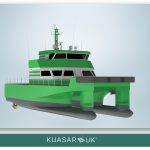Innovation through Maritime Research and Innovation UK (MarRI-UK)
A day of exciting webinars and virtual demonstrations that showcase some of the most exciting breakthroughs in UK Innovation. Featuring Keynote Speaker – Petra Wilkinson, Director of Maritime, Department for Transport.
When: 9am – 3pm, 12th October, 2022
Format: Online Conference
Agenda
09:00 – Opening remarks
 John Hudson, Director of MarRI-UK
John Hudson, Director of MarRI-UK
09:05 – DfT Keynote speech – government supports innovation and technology development in maritime
Petra Wilkinson, Director of Maritime, Department for Transport
09:15 – An Introduction to MarRI-UK
An introduction of MarRI-UK and its latest activities
Richard Westgarth, BMT, Chair of MarRI-UK working group
09:40 – Q&A
09:45 – Hydrodynamic data integration for safe port navigation
Andy Plater, University of Liverpool
To ensure safe and efficient access to ports, University of Liverpool has developed Eigenshores, a system using a combination of data technologies (satellite and land-based radar) and novel analysis methods (Machine Learning and modal decomposition) in a unique and integrated way to routinely and automatically detect changes in sub- and intertidal bathymetry to alert changes in water depth that threaten safe navigation. Further to enhancing port safety, the system will optimize the deployment of maintenance surveys and dredging and thus reduce fuel use, CO2 emissions and cost.
Who should attend: Port authorities, Marine dredging companies
10:15 – Highly automated non-destructive testing of ship structures with a thrust vectoring drone
Ken Wahren, CEO, Autonomous Devices
Argus is a highly automated system for remote NDT, especially the capture of thickness measurements during surveys. Argus overcomes severe access challenges for inspectors, enabling safer and more efficient inspection of even the most challenging geometries. In the long term, Argus systems resident on future Maritime Autonomous Surface Ships will provide shore control operators with a flexible telepresence for a range of remote inspection and investigation tasks.
Who should attend: Classification society, Shipyards, Ship owners
10:45 – Break
11:00 – Lookout Not Looking Out
The bridge watchkeepers must maintain a visual lookout as required by the International Regulations for Preventing Collisions at Sea. The ever-increasing number of multifunction displays (MFDs) on modern ship bridges are meant to facilitate the watchkeeper in improving navigational safety. On the contrary, a high proportion of accidents attributed to lack of a proper lookout with the anecdotal evidence suggesting that the watchkeepers are spending too much time on MFDs. This research investigates the underlying issues with outputs leading to defining the an ‘optimised’ visual scanning pattern for maintaining an efficient lookout as well as development of an ideal Human Interface Design concept for the modern ship’s bridges.
Abdul Khalique, Head of Maritime Centre, Liverpool John Moores University
Who should attend: Deck watchkeeping personnel, deck cadets and officers, training providers, MCA, MAIB, MNTB, ship operators, Ship owners
11:30 – Global Ocean Surveillance Network
Andrew Durrant, CEO, PicSea
PicSea has developed a low-risk, affordable, quick solution to conduct underwater photographic surveys. The solution of a swarm of Autonomous Underwater Vehicles (AUV’s) can be deployed underwater to collect images and data according to defined routes. Following retrieval, data can be downloaded and post-processed. A georeferenced 3D reconstruction of the target area can be produced.
Who should attend: Offshore windfarm operators, Oil and gas professional, Port infrastructure maintainers, Fishing / Fisheries, Marine scientists, Marine Archaeologists
12:00 – Lunch break
13:00 – Effective assessment of maritime cyber risks by using MaCRA
MaCRA is a unique maritime cyber risk assessment solution for international shipping operators and insurer. It dynamically responds to changes made within ships’ systems and to threats associated with voyage-specific route and cargo contexts to provide real-time, operation-specific cyber risk assessment. Join us to see a demonstration.
Kevin Forshaw, Director of Industrial and Strategic Partnerships, Faculty of Science and Engineering, University of Plymouth
Who should attend: Ship operators, Insurers
13:30 – Offshore Charging for Hybrid and Electric Vessels
Andy Collins, Commercial Director, Oasis Marine Power
The OASIS Power Buoy is an offshore mooring station which is also connected to wind turbines allowing vessels to moor up, plug in, and recharge with a zero-emission power source fed directly from wind turbines. Initially aimed at Wind Farm Crew Transfer Vessels (CTVs) the Oasis Power Buoy provides the critical need for offshore charging infrastructure for hybrid and all-electric vessels. By advancing the duration that hybrid and electric CTVs can operate using low-cost renewable energy, Oasis Marine are making these zero-emission journeys viable and are enabling major carbon reductions for the offshore wind industry.
Who should attend: Ship owners, Ship designers
14:00 – Intelligent Ship Centre (IGNITE)
Laurie Wright, Associate Professor of Marine Sustainability, Solent University
The IGNITE project is developing a scaled demonstration and training facility for remotely operated Maritime Autonomous Surface Ships (MASS). Solent University is the only institution worldwide with both advanced manned model and simulation capability. Working with leading experts, Wärtsilä the IGNITE project will innovatively link the manned model and simulation centres. The project will enable complex simulation and training in real traffic interactions and high-risk manoeuvres in a safe and controlled environment.
Who should attend: Ship Owners, Ship Designers
14:30 – Closing
Richard Westgarth, BMT, Chair of MarRI-UK working group


